Grow: Tiny Garden? No Problem!
Mike and Pat Worsham shared this great story of how adding just one potted butterfly milkweed in a sunny spot provided monarch habitat. Even if you don’t have much space, you can still make a difference!
Here’s an easy way to plant natives and create your own small butterfly garden. All you need is a flower pot that drains well and some butterfly milkweed (Asclepias tuberosa). This might make a fun school science project too. The flower pot can sit on a patio, an apartment or condo balcony or in our case we use a ceramic pot placed on our driveway. You’ll want to find a place that receives a good amount of sun for most of the day. Our pot is fairly deep since most native plants like butterfly milkweed produce a deep taproot and need room to grow. Butterfly milkweed is drought tolerant but since we are using a container we need to be careful not to let it get too dry.
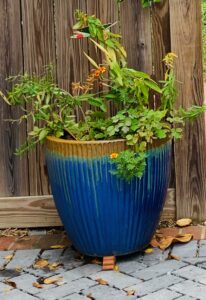
Butterfly milkweed is a native perennial that has beautiful bright yellowish-orange flowers. The flowers are a rich source of nectar that attract a number of pollinators like butterflies, bees and even hummingbirds although the hummers seemed to prefer the coral honeysuckle (Lonicera sempervirens) that is growing on the fence just behind the milkweed (more on this plant later).
We were very surprised and excited when we happened to find a monarch caterpillar happily chewing away on the milkweed on September 1st. We knew butterfly milkweed is a host plant of the monarch but we hadn’t seen any monarchs flying anywhere around this plant and certainly didn’t know one had laid eggs. We are by no means experts on monarchs and knew almost nothing about their lifecycle so what we got to see was a wonderful learning experience for us.
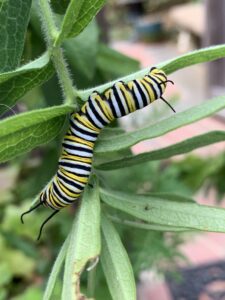
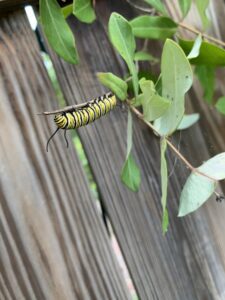
We started looking up information on line to try to understand what this caterpillar or, as we began saying our little “cat”, was up to from sites such as: https://monarchjointventure.org/monarch-biology/life-cycle.
We did not see when the egg hatched or when the larva grew through its instar stages. We believe we first spotted it after it reached its fifth instar stage. We checked the next day and could not find our cat on the milkweed and thought it had become a meal for something like a wasp.
Then we found it on the that nearby coral honeysuckle. It must have dropped off the milkweed onto the driveway, made its way across the pavers and then scaled the wooden fence up to the honeysuckle.
We continued to check on it for the next few days and on the afternoon of September 4th. we found it hanging in its “J” shape from another part of the coral honeysuckle. We learned this “J” is the “pre-pupa” stage and happens just before a cat forms a chrysalis and begins its metamorphosis into an adult monarch.
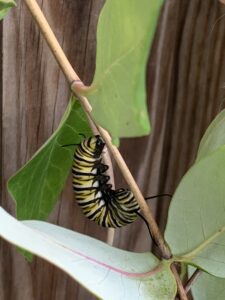
We continued to check on it over the next few days and were absolutely fascinated to see the different stages of metamorphosis this complex little creature went through.
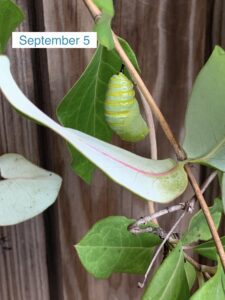
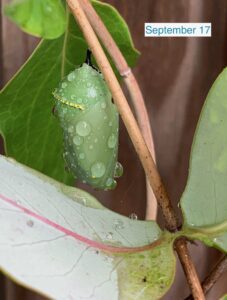
And then on September 19th we had a beautiful boy emerge or “eclose” from its chrysalis! The male markings (pheromone pouches) on the hind wings are unfortunately not visible in this photo but they were there when we looked. We didn’t want to be too intrusive to take more
photos so we left him alone. Apparently he didn’t stick around very long because when we went back he was gone.
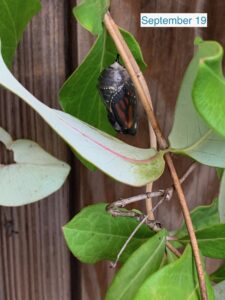
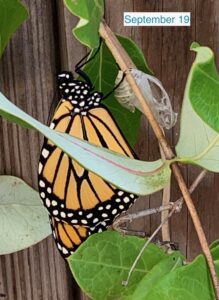
Safe travels little guy and we hope your offspring come back to us and start this fascinating process all over again next year!
(photo credit: Mike and Pat Worsham)
